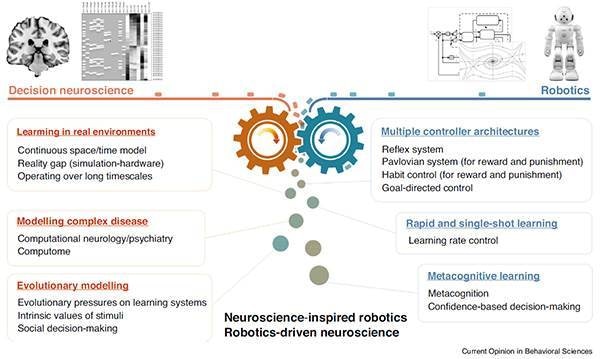Feb 21 2019
Researchers from KAIST, the University of Cambridge, Japan’s National Institute for Information and Communications Technology, and Google DeepMind have expressed that an individual’s understanding of how humans make smart decisions has now arrived at a crucial point in which robot intelligence can be greatly improved by imitating approaches used by the human brain when individuals have to make decisions in their daily lives.
 Overview of neuroscience-robotics approach for decision-making. The figure details key areas for interdisciplinary study (Current Opinion in Behavioral Sciences). (Image credit: KAIST)
Overview of neuroscience-robotics approach for decision-making. The figure details key areas for interdisciplinary study (Current Opinion in Behavioral Sciences). (Image credit: KAIST)
It has now become essential for both autonomous robots and humans to consistently learn and adapt to new environments because of the rapid changes in today’s world. However, the difference is that humans have the potential to make decisions based on unique scenarios, while robots make decisions based on predetermined data.
The central control systems of robots are still considered to be inferior to those of humans in spite of the efficient progress executed in strengthening the physical ability of robots. These systems play a vital role in directing how robots decide what they have to do at any instant of time. To be more specific, robots mostly depend on pre-programmed instructions that help in directing their behavior, and hence they fail to possess the authenticity of human behavior, referring to the potential and flexibility to rapidly learn and adapt.
Professor Sang Wan Lee from the Department of Bio and Brain Engineering, KAIST and Professor Ben Seymour from the University of Cambridge and Japan’s National Institute for Information and Communications Technology together applied neuroscience in robotics and projected a case in which robots will have to be designed according to the principles of the human brain. According to these professors, it is possible to immensely improve robot intelligence by imitating tactics used by the human brain while making decisions in everyday life.
For a long time, importing human-like intelligence into robots has been a complicated process without being aware of the computational principles of how decisions are made by the human brain, basically, referring how to go about translating the activity of the brain into a computer code for the robots’ “brains.”
Nevertheless, researchers presently argue that there are adequate details of this code, and hence this code can be efficiently written into robots. They came up with this decision based on a series of latest discoveries in the computational neuroscience domain. An example that was discovered refers to the human brain’s “meta-controller.” This new discovery is a mechanism used by the human brain to decide how to switch between varied subsystems in order to perform difficult tasks. The human pain system is another example which permits them to safeguard themselves in hypothetically dangerous environments.
Copying the brain’s code for these could greatly enhance the flexibility, efficiency, and safety of robots.
Sang Wan Lee, Professor, Department of Bio and Brain Engineering, KAIST
The research team emphasized that this inter-disciplinary method is capable of providing the same number of benefits to neuroscience as that provided to robotics. The latest outburst of interest in what exists behind psychiatric disorders such as depression, addiction, and anxiety led to the discovery of a set of refined theories that are intricate and tough to test without some kind of improved situation platform.
We need a way of modelling the human brain to find how it interacts with the world in real-life to test whether and how different abnormalities in these models give rise to certain disorders. For instance, if we could reproduce anxiety behavior or obsessive-compulsive disorder in a robot, we could then predict what we need to do to treat it in humans.
Ben Seymour, Professor, University of Cambridge and Japan’s National Institute for Information and Communications Technology
The team believes that developing robot models of varied psychiatric disorders, in a manner similar to how researchers presently use animal models, will turn out to be a significant technology in the field of clinical research in the years to come.
The research team also specified that there might be several other benefits to humans and intelligent robots acting, behaving, and learning in the same way. Future societies will have both humans and robots living and working among each other, and their potential to cooperate and empathize with robots may become much greater if people start to believe that the robots also have started to think like them.
We might think that having robots with the human traits of being a bit impulsive or overcautious would be a detriment, but these traits are an unavoidable by-product of human-like intelligence. And it turns out that this is helping us to understand human behavior as human.
Ben Seymour, Professor, University of Cambridge and Japan’s National Institute for Information and Communications Technology
The framework for accomplishing this brain-inspired artificial intelligence featured in two journals, Science Robotics (10.1126/scirobotics.aav2975) on January 16th and Current Opinion in Behavioral Sciences (10.1016/j.cobeha.2018.12.012) on February 6th, 2019.